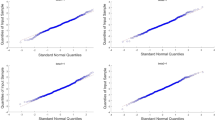Abstract
This paper discusses regression analysis of interval-censored failure time data arising from the accelerated failure time model in the presence of informative censoring. For the problem, a sieve maximum likelihood estimation approach is proposed and in the method, the copula model is employed to describe the relationship between the failure time of interest and the censoring or observation process. Also I-spline functions are used to approximate the unknown functions in the model, and a simulation study is carried out to assess the finite sample performance of the proposed approach and suggests that it works well in practical situations. In addition, an illustrative example is provided.
Similar content being viewed by others
References
Chen C, Lu T, Chen M, et al., Semiparametric transformation models for current status data with informative censoring, Biometrical Journal, 2012, 54(5): 641–656.
Finkelstein D, A proportional hazards model for interval-censored failure time data, Biometrics, 1986, 42: 845–854.
Huang J, Efficient estimation for the proportional hazards model with interval censoring, The Annals of Statistics, 1996, 24(2): 540–568.
Sun J, The Statistical Analysis of Interval-Censored Failure Time Data, Springer Science & Business Media, New York, 2006.
Finkelstein D and Wolfe R, A semiparametric model for regression analysis of interval-censored failure time data, Biometrics, 1985, 41: 933–945.
Zeng D, Cai J, and Shen Y, Semiparametric additive risks model for interval-censored data, Statistica Sinica, 2006, 16: 287–302.
Wang L, McMahan C, Hudgens M, et al., A flexible, computationally efficient method for fitting the proportional hazards model to interval-censored data, Biometrics, 2016, 72(1): 222–231.
Zeng D, Mao L, and Lin D, Maximum likelihood estimation for semiparametric transformation models with interval-censored data, Biometrika, 2016, 103(2): 253–271.
Zhou Q, Hu T, and Sun J, A sieve semiparametric maximum likelihood approach for regression analysis of bivariate interval-censored failure time data, Journal of the American Statistical Association, 2017, 112(518): 664–672.
Zeng D, Gao F, and Lin D, Maximum likelihood estimation for semiparametric regression models with multivariate interval-censored data, Biometrika, 2017, 104(3): 505–525.
Huang X and Wolfe R, A frailty model for informative censoring, Biometrics, 2002, 58: 510–520.
Zhang Z, Sun L, Sun J, et al., Regression analysis of failure time data with informative interval censoring, Statistics in Medicine, 2007, 26: 2533–2546.
Wang P, Zhao H, and Sun J, Regression analysis of case K interval-censored failure time data in the presence of informative censoring, Biometrics, 2016, 72(4): 1103–1112.
Ma L, Hu T, and Sun J, Cox regression analysis of dependent interval-censored failure time data, Computational Statistics and Data Analysis, 2016, 103: 79–90.
Zhao S, Hu T, Ma L, et al., Regression analysis of interval-censored failure time data with the additive hazards model in the presence of informative censoring, Statistics and Its Interface, 2015, 8(3): 367–377.
Xu D, Zhao S, Hu T, et al., Regression analysis of informatively interval-censored failure time data with semiparametric linear transformation model, Journal of Nonparametric Statistics, 2019, 31(3): 663–679.
Lin D, Wei L, and Ying Z, Accelerated failure time models for counting processes, Biometrika, 1998, 85(3): 605–618.
Jin Z, Lin D, Wei L, et al., Rank-based inference for the accelerated failure time model, Biometrika, 2003, 90(2): 341–353.
Zeng D and Lin D, Efficient estimation for the accelerated failure time model, Journal of the American Statistical Association, 2007, 102(480): 1387–1396.
Rabinowitz D, Tsiatis A, and Aragon J, Regression with interval-censored data, Biometrika, 1995, 82(3): 501–513.
Betensky R, Rabinowitz D, and Tsiatis A, Computationally simple accelerated failure time regression for interval censored data, Biometrika, 2001, 88: 703–711.
Nelsen R, An Introduction to Copulas, Springer Science and Business Media, New York, 2006.
Lu M, Zhang Y, and Huang J, Estimation of the mean function with panel count data using monotone polynomial splines, Biometrika, 2007, 94(3): 705–718.
Schumaker L, Spline Functions: Basic Theory, Cambridge University Press, Cambridge, 2007.
Murphy S and Vaart A, On profile likelihood, Journal of the American Statistical Association, 2000, 95(450): 449–465.
Author information
Authors and Affiliations
Corresponding author
Additional information
This research was supported by the National Natural Science Foundation of China under Grant No. 11671168 and the Science and Technology Developing Plan of Jilin Province under Grant No. 20200201258JC.
Rights and permissions
About this article
Cite this article
Zhao, S., Dong, L. & Sun, J. Regression Analysis of Interval-Censored Data with Informative Observation Times Under the Accelerated Failure Time Model. J Syst Sci Complex 35, 1520–1534 (2022). https://doi.org/10.1007/s11424-021-0209-y
Received:
Revised:
Published:
Issue Date:
DOI: https://doi.org/10.1007/s11424-021-0209-y




